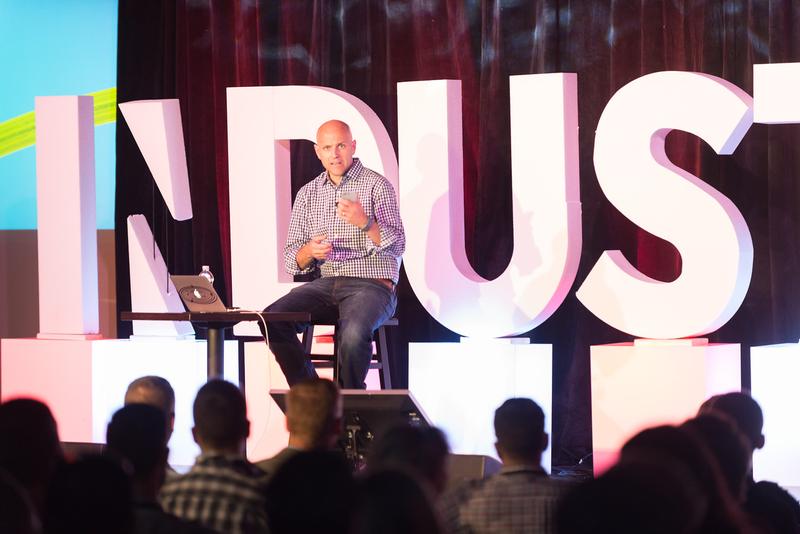”There is no point in having a 5-year plan in this industry. With each step forward, the landscape you’re walking on changes. So we have a pretty good idea of where we want to be in six months, and where we want to be in thirty years. And every six months we take another look at where we want to be in thirty years to plan out the next six months.”1
How fast can an ant travel? It’s an easy question to answer with the help of the internet: about 300 meters per hour, which translates to 0.19 miles per hour. But wait, there’s more than one right answer. Ants also move at 1,000 miles per hour—the speed at which ants, humans, and everything else on Earth are rotating. Or how about 67,000 miles per hour? That’s how fast the Earth travels around the sun. (Now 1,000 mph seems puny.) There are even more right answers because our solar system is rotating around the galaxy at 483,000 mph. And our galaxy—you guessed it—itself moves at over 1,300,000 mph relative to cosmic background radiation.2
Phew. The lesson here is that there are a number of correct answers to the ostensibly simple question “how fast is an ant?” depending on what it’s relative to—the reference frame. (That’s how physicists explain why a passenger on a train might feel like they’re sitting still whereas an observer standing on the platform sees them moving by at 50 mph.) Relative to the grass, the ant is moving at one speed, but the hypothetical alien—with a galactic frame of reference—would give a different answer.
The same goes for technological progress. In our industry, product managers are the tiniest of ants. Our reference frame is day-by-day, sprint-by-sprint, feature-by-feature. What’s happening today, tomorrow, next month? Like the ant, we’re deep in the weeds, intimately familiar with the dirt but unaware of just how fast the world is moving under our feet. We can easily become myopic to the pace of technology and to the larger forces that will ultimately have more influence whether our product succeeds or fails more than which feature comes next.
How can we make sure we take the alien’s frame of reference?

Blockbuster CEO Jim Keyes was asked about the future of online media in 2008. Confronting the threat presented by Netflix, he said, “DVDs are a melting glacier. Yes, it’s melting, but it’s a slow melt.” Less than two years later, Blockbuster was bankrupt. His predecessor, Jim Antioco, said they “didn’t believe that technology would threaten the company as fast as critics thought.”3
When we read about failed companies such as Blockbuster, Kodak, or RIM, we’re often told that they were “caught by surprise” or “didn’t see it coming.” The truth is much more complicated. In each of these examples, the companies were acutely aware of the threat posed by the new technology. In fact, they were often the first to see it—Kodak invented digital photography, and RIM brought the first smartphones to market. What they were wrong about, however, was just how fast the technology was moving. They had the wrong frame of reference. Blockbuster looked at how many DVDs they rented today compared with yesterday and felt placated. But you’ll never notice how fast a glacier is melting if you’re only comparing measurements minute by minute.
We fall into a curious trap when we think about the future—we know too much to be dangerous. If I ask you to tell me where your product will be in two years, I suspect you’ll jump right into technical details. Which mobile platform will be most popular? Will VR gain traction with consumers? Where will the bulk of online advertising will be concentrated? That’s unavoidable—two years isn’t very far away. Measured on this scale, changes are difficult to notice. Think about this the next time you read a product review.4

Left: Steve Wozniak sits by the new Apple IIgs on September 16, 1986. Photograph by Steve Castillo, AP.
Right: Steve Wozniak holds an iPhone on February 6, 2013. Photograph by Hannes Magerstaedt, Getty Images.
But what if I ask you to imagine your product in thirty years? Something appealing happens when you contemplate that time horizon. It’s so far into the future that the little details have to fall away. Who the hell knows what device we’ll be using to communicate in 2046?! It’s impossible to predict. Yet it’s easy to anticipate that we’ll be using something that will be even easier, faster, more powerful, and more ubiquitous than the smartphones of today. Zooming out to see the industry at a geological time scale brings things into focus: technology is progressing faster than most of us imagined, and will only continue to do so.
The year 1986—thirty years ago—fell within most of our lifetimes (or close enough). It wasn’t that long ago. But think about how far technology has advanced since 1986. The personal computer on a worker’s 1986 desktop has morphed into the smartphone, a device that fits into our pockets, is more than 300x faster, has 2,000x as much memory, and costs less than 5% as much. (Oh, and it’s always connected to everyone else on Earth and the entire sum of human knowledge.)
If you want to prepare for the future, move the goalposts. Try a thirty-year plan. I’m not talking about a thirty-year roadmap—that’s ridiculous. A roadmap is “what we will build.” This exercise aims to answer, “where might the world be?” We want to think about the external forces that will shape the feature, not the features derived from them. This is also about forecasting, not predicting. Predictions concern themselves with future certainties, whereas forecasts map out ranges of possible outcomes, continuously updated as more information becomes available. Think weather forecast, not lottery predictions.5
In many ways, this is similar to scenario planning—a technique pioneered by military intelligence and used today by many different kinds of organizations, especially in stodgy old industries like energy and consumer staples. Peter Schwartz, one of the gurus of scenario planning, describes it as a process where “managers invent and then consider, in depth, several varied stories of equally plausible futures.”6

This essay is based on my keynote at Industry: The Product Conference, held in Cleveland, Ohio on September 15, 2016.
Photograph by Gregory Wilson.
Schwartz offers a useful framework for leading the discussion and contemplating the types of forces that will shape your future. He uses the handy acronym STEEP—Social, Technological, Economic, Environmental, and Political. They’re a helpful way to compensate for the blind spots we have in tech—when was the last time you considered how climate change or population growth could shape your product’s future?
When you get to the T-forces (Technological), be careful. This is where you can fall into the trap of trying to predict products and technologies rather than imagining trends and forces. To help with this, I recommend consulting Kevin Kelly’s latest book, The Inevitable. Unlike futurists who try to predict, Kevin focuses instead on identifying forces, which he calls “motion verbs”:
I make no attempt to predict which specific products will prevail next year or the next decade, let alone which companies will triumph. These specifics are decided by fads, fashion, and commerce, and are wholly unpredictable. But the general trends of the products and services in 30 years are currently visible.
Their basic forms are rooted in directions generated by emerging technologies now on their way to ubiquity. This wide, fast-moving system of technology bends the culture subtly, but steadily, so it amplifies the following forces: Becoming, Cognifying, Flowing, Screening, Accessing, Sharing, Filtering, Remixing, Interacting, Tracking, Questioning, and then Beginning.7
To take an example, imagine you are a leader at LEGO and want to plan for the future. First, you need to keep your LEGO vision and mission statements handy: “Inventing the future of play” and “Inspire and develop the builders of tomorrow.” Cool. (Notice that your mission is not to “sell injection-molded plastic bits with licensed brands.”)
If you’re an ant, you might look at a technology like 3D printing and try to predict if and when it will form a threat to the LEGO core business. It’s easy to be dismissive—the technology is still nascent, and it feels like it will be years before 3D printing is cheap, fast, and high quality enough to threaten your injection-molded LEGO pieces. But that’s the wrong way to think about the future (slow-melting glaciers). Put yourself instead in the year 2046. Suddenly 3D printing feels a lot more inevitable. Is it likely that in 2046 there will be a cheaply accessible desktop printer that can crank out LEGO bricks that are as good as or better than the bricks of today? It’s a huge stretch to believe there won’t be. Recognizing that such an advancement is inevitable over the long term is sobering.
What about some of Kelly’s other forces, such as cognifying (previously dumb things getting smarter through artificial intelligence—everything from airplanes to thermostats), sharing (from Facebook updates to Wikipedia), or accessing (every year we own less of what we use—think compact disc vs. Spotify, or car ownership vs. Uber)? Might there come a day where I pay for a monthly subscription for every LEGO product ever made, plus the millions of sets and bricks created and shared by other LEGO aficionados? And those bricks and assembled models are smart? Now you’re thinking like an alien!

Photograph by Miguel Raul Granda Barbon, Flickr.
Once you have considered what these possible futures look like, you can form an opinion about where your product should go, which long-term trends you can’t ignore, and against which trends you might need to hedge. Your periodic thirty-year plan feeds into your six-month plan.8 It should also help you with every product manager’s toughest challenge: deciding which things not to do. Which efforts just aren’t important to the long-term yet distract you from what does matter?
This exercise doesn’t have to happen often—once or twice a year is probably ideal. It is possible to spend too much time with your head in the far future and end up being way too early. Periodically setting aside the ant’s eye view for an alien’s tour of the universe can help you put the future into perspective; plus it’s fun. It’s sooner than you think.
—30—
Recommended Reading
- Kevin Kelly, The Inevitable
- Peter Schwartz, The Art of the Long View
- Nate Silver, The Signal and the Noise: Why So Many Predictions Fail-but Some Don’t
- Philip Tetlock, Superforecasting: The Art and Science of Prediction
Thanks to Mike Belsito, Catherine Shyu, and to the audiences at Industry 2016 and Colorado Product/Denver Startup Week 2016.
-
Ben Barry. “Facebook’s Little Red Book,” formerly at:
http://benbarry.com/project/facebooks-little-red-book(blog). Accessed September 28, 2016. Update in 2021: This link is no longer available but you can find some scans in an article here. ↩ -
Andrew Fraknoi, “How Fast Are You Moving When You Are Sitting Still?”, Astronomical Society of the Pacific, Spring 2007. Accessed June 29, 2016. ↩
-
Just a suggestion: if financial analysts ask you to comment on the future of your business, try to avoid invoking global warming metaphors.
Rick Aristotle Munarriz, “Blockbuster CEO Has Answers”, The Motley Fool, December 10, 2008. Accessed September 29, 2016.
John Antioco, “How I Did It: Blockbuster’s Former CEO on Sparring with an Activist Shareholder”, Harvard Business Review, April 2011. Accessed September 29, 2016. ↩
-
Here’s one: “But the iPhone 7 is the most iterative update of all. For the third year in a row, Apple is peddling the same look while its competitors like Samsung have out-designed it.”
Steve Kovach. “The iPhone 7 is the same old thing, but it’s going to sell like hotcakes anyway”, Business Insider, September 7, 2016. Accessed October 3, 2016. ↩
-
Philip Tetlock, Superforecasting: The Art and Science of Prediction. ↩
-
Traditional scenario planning is a bit heavyweight and stuffy for most tech companies, so I don’t recommend trying to follow it to the letter. But there are some useful frameworks, and Peter Schwartz’s book is the best and most accessible guide.
Peter Schwartz. The Art of the Long View, (New York: The Crown Publishing Group, 1996). Kindle Edition, Location 72. ↩
-
Emphasis mine.
Kevin Kelly. The Inevitable: Understanding the 12 Technological Forces That Will Shape Our Future, (New York: Penguin Publishing Group, 2016). Page 8. ↩
-
See the quote at the top of this page from Facebook’s Little Red Book.
Ben Barry. “Facebook’s Little Red Book,” formerly at:
http://benbarry.com/project/facebooks-little-red-book(blog). Accessed September 28, 2016. Update in 2021: This link is no longer available but you can find some scans in an article here ↩

